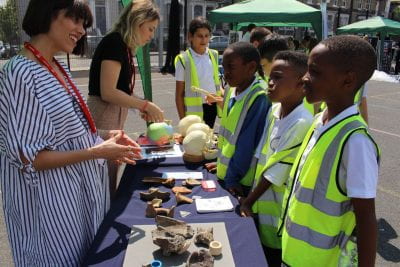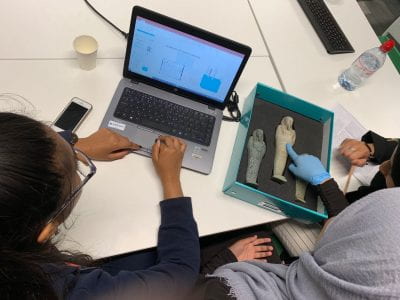A summer of innovation, creativity and learning: engaging with east London schools
By e.edem-jordjie, on 4 September 2019
This blog has been written by Edinam Edem-Jordjie, a STEP Intern with the UCL East Community Engagement Team.
We have had a very busy summer at UCL Culture. As part of our commitment to establishing a positive community in east London with which to work with long-term in advance of the opening of the UCL East campus, UCL Culture has been involved in a number of activities with the communities of east London, this summer. Read on for details on what we got up to!
George Mitchell Museum of Objects
On Tuesday 25th June at George Mitchell School, two pupils from year 5 cut a red ribbon across the school’s Art studio to declare the George Mitchell Museum of Objects open to the public. The museum, called ‘George Mitchell Museum of Objects’, is curated around the theme of life, with the students using objects from The Petrie Museum of Egyptian Archaeology and The Grant Museum of Zoology as inspiration.
The museum emerged from a project run by the schools engagement team called Creating Aspirations, which aims to encourage a love of museum and object based learning. Over the past year, the project has seen year 5 pupils visiting UCL’s Museums and Collections, local art organisations such as the William Morris Gallery and also undertaking various workshops back in their classrooms, where they, with support from UCL staff and students, have created works of art such as sculptures and prints which were exhibited in the museum.
The museum opened with a launch celebration attended by pupils, staff, parents and members of the local community. During the celebration, the pupils worked as tour guides, relating their experiences and the processes behind each object in the museum.
Every object in the museum bar a certificate which detailed how the pupils have adopted a specimen from the Grant Museum, had been made by the pupils themselves. The sculptures on display included papier-mâché eggs alongside a selection of painted replica clay shabtis and hieroglyphic tablets. Drawings on display included a painted paper tapestry, four portraits of Flinders Petrie on canvas and more than thirty intaglio prints of Ancient Egyptian inspiration.
The museum also included stop motion films and photographs of their favourite specimens from the Grant Museum.
You can find out more about the project here and the schools engagement workshops on the UCL Culture Website.
Breaking Ground at UCL East
On the 2nd July, the Mayor of London, Sadiq Khan, and UCL President & Provost, Professor Michael Arthur broke ground at UCL East, as construction began on the innovative new campus, which together with the nearby Stratford Waterfront Site at Queen Elizabeth Olympic Park, , forms East Bank, a new cultural hub for London. Speaking of the event, Professor Michael Arthur, UCL President & Provost, said: “As one of the world’s leading universities, we address many of the most pressing global challenges of our time. UCL East will take this one step further. We are proud to be part of East Bank and excited to break ground on our site today – a major milestone in making the collective vision a reality.”
The breaking ground ceremony marks the beginning of the largest single expansion of UCL since it was founded nearly 200 years ago. The new campus will provide multi-disciplinary research, teaching and innovation in areas as diverse as robotics, smart cities, culture and conservation. Formed of two buildings – Marshgate I and Pool Street West, the campus will house 4,000 students and will feature a range of uses, including student accommodation, retail units, high tech laboratories and designated areas for working with schools, charities and local groups. The new campus will be at the heart of London’s new powerhouse for innovation, creativity and education with the BBC, London College of Fashion, Sadler’s Wells, the Smithsonian and V&A all part of East Bank. You can read more about East Bank project here.
At the event, Sadiq Khan was joined at UCL East by children from local schools based in Newham and Hackney to bury a time capsule symbolising the huge impact the East Bank project will have on the capital’s future generations. The objects in the capsule, including keys, newspapers and coins, were chosen by school children in a competition. The children were given £100 to spend and had to choose objects that people will want to study in 100 years’ time due to their significant impact on lives of people today or because they have the potential to improve the way people will work, study, perform, play or live in the future. The moment was accompanied by a fanfare from a group of young east London musicians from local schools, specially commissioned by the BBC.

Mayor of London, Sadiq Khan, and UCL President & Provost, Professor Michael Arthur among others celebrating the East Bank breaking ground at UCL East.
The event was covered in The Evening Standard and The BBC. You can read more about it here.
Petchey Academy & UCL Science Festival.
On the 16th July, under the blazing sun in Hackney, the very first Petchey Academy & UCL Science Festival took place. Hosted in collaboration with Petchey Academy in Hackney, the festival emerged out of UCL Culture’s Bio-Robotics and Animal Movement workshops that run at the UCL Grant Museum of Zoology. The free workshops are aimed at pupils and from east London and encourage students to engage with STEM, through exploring the links between robots, computer programming and animal movement. The festival was the culmination of a yearlong project that has seen Petchey Academy pupils and UCL Culture’s Schools Engagement Team, with support from UCL students Maisha Hussain and Tyra Enchill along with Dr Daniil Nikitichev from the UCL Department of Medical Physics and Bioengineering, working together to design a jumping robot inspired by the kangaroo skeleton at the UCL Grant Museum of Zoology. As part of the project, a 3D printer was built, which will eventually print the parts for the kangaroo robot.
The festival saw students, parents and members of the local community enjoying a free interactive show from the Science Museum in the auditorium before venturing outside to the fair where they got to engage with UCL volunteers, Petchey pupils and external partners in a number of experiments, demonstrations and displays.
Staff and students from the UCL Faculty of Engineering Sciences, Medical Physics and Biomedical Engineering, and UCL Institute of Archaeology ran interactive stalls which demonstrated aspects of their work, such as research into the craters on the moon. The Petchey Academy robotics team showcased their robot ‘The Beast’ which was designed and built for the annual international FIRST Robotics competition in New York. There were also a number of activities that visitors could take part in such as keyhole surgery and reconstructing fragments of a replica skull dug up during an archaeological dig.
You can find out more about the festival here and the schools engagement workshops on the UCL Culture Website.
The East Education Summer School
The East Education Summer School is a new scheme that was set up last year by the London Legacy Development Corporation, that gives 13 – 16 year olds from Newham, Hackney, Waltham Forest or Tower Hamlets, the chance to experience a range of courses in culture and arts delivered by world class organisations such as the BBC, UAL’s London College of Fashion, Sadler Wells, the V&A in partnership with the Smithsonian and of course, UCL. This Summer School is just one example of how the partners coming to Queen Elizabeth Olympic Park are already working together with local communities in east London to make sure that the benefits of the project are felt by all.
Over the course of two weeks, 450 young people took part in courses that ran for anything from four hours to five days in a range of disciplines, including; Architecture, Dance, Theatre and Curation. UCL Culture hosted two courses, which explored curation in different ways.
Set up by the Head of Schools Engagement, Celine West, Young Curators was a two day course aimed to aid creative thinking and get the students to think about what goes into curating a successful exhibit, from selecting the objects to choosing what story or narrative the exhibition presents. Students got to handle objects from around the world and curate an online exhibition using objects in their everyday lives with the help of poet Toni-Ann La-Crette.
Tomb Raider in the Museum, also a two day course, gave students the opportunity to follow the journey and process of objects from archaeological excavation to museum display. Students got to handle ancient Egyptian objects, learn how to catalogue, label and display a collection and present a shot informative museum-style talk.
The summer school culminated in an end of school graduation/celebration ceremony where students got to showcase what they learnt and achieved through the summer school.
The London Legacy Development Corporation plans to run the summer school again next year. You can read more about the summer school and find out how to get involved next year here.
We have had a great summer and now that summer is over and a new term is near, we’re looking ahead to our autumn activities. If you are interested in finding out what more UCL is doing in east London this upcoming term, please send us an email at: engagement-east@ucl.ac.uk or follow our twitter account: @UCLEngage.
 Close
Close










